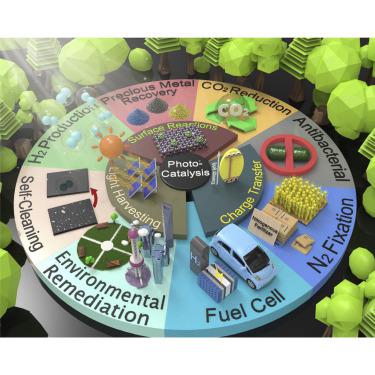Chem Catalysis ( IF 11.5 ) Pub Date : 2022-05-05 , DOI: 10.1016/j.checat.2022.04.007 Xinru Li 1, 2 , Yao Chen 1 , Ying Tao 1 , Li Shen 2 , Zhenmin Xu 1, 3 , Zhenfeng Bian 1 , Hexing Li 1

|
The photocatalysis process comprises both the catalytic steps, such as diffusion, adsorption, surface reaction, and desorption, and the photoelectric conversion steps, including light harvesting, semiconductor excitation, photo-charge migration, and photoelectron-hole separation. The strategic development of efficient photocatalysts and photocatalytic reaction technologies is crucial for coping with the challenges of photocatalysis in practical applications. First, photocatalytic performance greatly depends on the physical and chemical properties of the photocatalyst, such as light absorbance, excitation, photocarrier recombination, instinct activity, molecule adsorption, and activation. Meanwhile, optimizing the photocatalytic reaction process can also improve the photocatalytic efficiency by inhibiting photoelectron-hole recombination, diminishing the secondary pollution from by-products, and avoiding poisoning deactivation. Herein, we outline the recent achievements in photocatalysis development and application.
中文翻译:

光催化的挑战及其应对策略
光催化过程既包括催化步骤,如扩散、吸附、表面反应和解吸,也包括光电转换步骤,包括光捕获、半导体激发、光电荷迁移和光电子-空穴分离。高效光催化剂和光催化反应技术的战略发展对于应对光催化在实际应用中的挑战至关重要。首先,光催化性能很大程度上取决于光催化剂的物理和化学性质,如光吸收、激发、光载流子复合、本能活性、分子吸附和活化。同时,优化光催化反应过程还可以通过抑制光电子-空穴复合来提高光催化效率,减少副产物的二次污染,避免中毒失活。在此,我们概述了光催化开发和应用方面的最新成就。











































 京公网安备 11010802027423号
京公网安备 11010802027423号